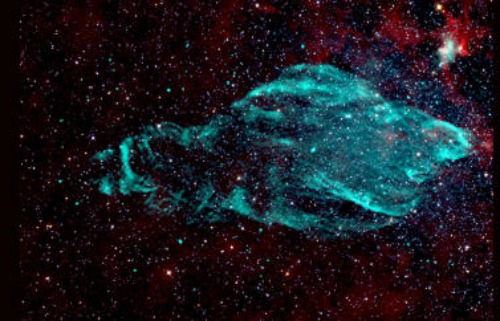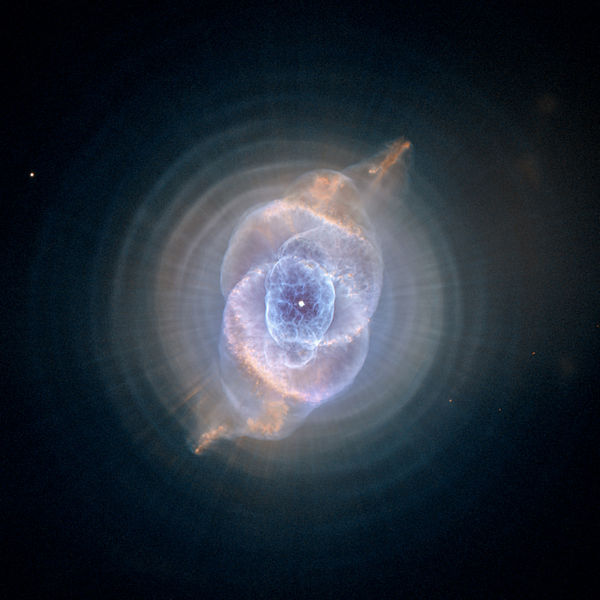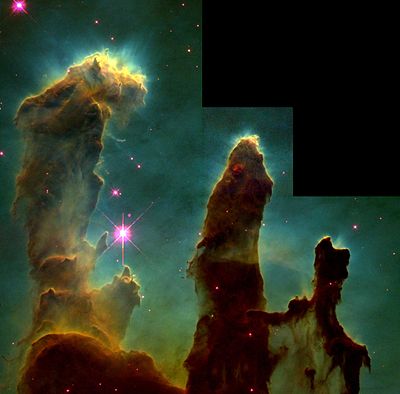Not long ago this object didn’t even have a name. It was just a dim hazy splotch in most telescopes, if they could see it at all. After being imaged by a high res wide radio telescope array in New Mexico, the one made famous in the movie Contact, it was christened the manatee nebula for its resemblance to the gentle and endangered marine mammals. More here.
Bear in mind the colors are false, human eyes can’t see the longish wavelength used to produce the pic, blues and violets were chosen to represent the very high energies blasting through the rarefied gas. But the intricate structures are all too real and the result of the initial, unimaginably violent process that created the embryonic nebula years ago, and the lethal radiation now saturating the region by a whizzing black-hole as the molecular debris expanded, on orders of magnitude that would make the Large Hadron Collider look like child’s play.
The Manatee Nebula is far more complex than the rudimentary image processing I put it through could possibly convey. The object is believed to be the result of a large star 18,000 light-years distant that went hypernova 20,000 years ago relative time. The tiny, unseen stellar core produced a black hole, a tiny point of no return about the size of a large city, spinning faster than a jet turbine, and with many times the mass of most stars like our sun crammed into that tiny volume. The powerful, insatiable polar magnetic jets created by the whirling black-hole wobble chaotically, like a top, over a period of months and years, producing dynamic wavelets and filaments in the ionized expanding gas. The nebula has grown prodigiously over the course of its short life, now stretching almost 700 light years across, producing the gorgeous image you see.
Nebula are hands down the most beautiful spectacles our breathtaking cosmos can produce. But with all those stunning sights to sample, in my view it would be hard to beat the Cat’s Eye Nebula, shown below in all its stellar glory, followed the iconic Pillars of Creation snapped by the Hubble. But even more heavenly sights are bound to await future electronic eyes that can detect even fainter light across the ocean in our 14 billion year old universe that extends over scales we can barely comprehend even by crude analogy.




HubbleSite.org (http://hubblesite.org/gallery/wallpaper/) has many gorgeous astronomical pictures. This one is my present desktop wallpaper.
So the Cat’s Eye is looking legth-wise down a structure similar to one of those Columns, I guess. Cool.
These posts of yours make me happy. Thank you.
otrame, actually the two are quite different in every respect. The Cat’s Eye is a roughly spherical region surrounding a dying star. The pillars are condensed clouds of gas/matter in which stars are born.
Actually, if you want a better explanation, click the pictures. It is confusing that “nebula” refers to so many different phenomena. They are all beautiful, for sure.
Fantastic! We certainly are a privileged generation, able to see these extraordinary things that our forebears were not even aware existed!
I love those pictures, and mourn that we are unable to experience the glory of the universe more. But I am thankful that I was born in a time when you can try and appreciate what is there for us without as much of it filtered through the distorted darkening lens of religion.
The Pillars of Creation would be a great wallpaper if not for the upper right corner which is missing because they pieced it together.
The European Southern Observatory also has some great stuff:
http://www.eso.org/public/images/archive/wallpapers/
Yeah, the good old Horsehead nebula seems to have taken a dive in popularity ever since the Pillars of Creation was imaged.
The vast universe. The mind numbingly hugeness. The aching stretches of time and distance. The distraction of telescopic magnification that makes the insanely far away as familiar as the corner store. The immensity,the stark emptiness between the scattered places of tenuous refuge. The soundless echoes, inaudible hissings and rumblings beyond our natural hearing, of the commerce between galaxies.
As profoundly spectacular as is our first plain sights of it is the unintelligible remoteness of all the places, one from another and from us. The size of it all is heart breaking. With that heartbreak comes the knowledge that our grandest adventures, out farthest travels, our bravest quests will be no more than a short walk to that corner store for a quart of milk and a pack of smokes.
Even so, it’s going to be quite the thing when greeting cards are sent from one planet to another as easily as they are now sent across town, eh?
Great image, superb write up. Cheers I love this stuff! :-)